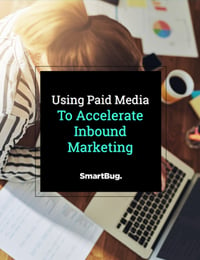
10 Landing Page Best Practices for PPC Campaigns
August 1, 2014
By Amber Kemmis
Let’s assume you currently send paid search or pay-per-click (PPC) traffic to landing pages, or pages with a form on them rather than your homepage or other site pages without conversion opportunities. (Note: If you’re not currently doing this, it’s time to change. By sending PPC traffic to a landing page, you increase the ROI of your total spend by providing your company with leads).
But what happens when your landing page is attracting a large amount of traffic, but isn’t getting conversions? Why doesn’t this traffic want to convert into a lead for your company? When this happens, companies will often instantly panic, then pause or lower paid their search spend.
While, it’s possible that your keyword optimization in your campaigns could be misguided, it’s best to first look at your landing pages and see how you can improve upon and make them more effective. To help you improve your paid search landing pages, here are ten best practices you can follow:
1. Know Which Persona You’re Targeting
By now, you have probably developed marketing personas (if you haven’t yet, start now) for your company. You will want to take your personas into consideration when drafting the copy for your PPC ads and landing pages. This is extremely important. If you’re not certain who you’re creating this ad for, getting conversions on your landing pages will be tough.
By relating to your personas needs and struggles, your landing page will be better able to establish trust. Trust encourages higher visit-to-lead conversion rates. Higher conversion rates equal a greater return-on-investment. A greater return-on-investment means a happier you! Bottom line: Focus on personas first.
2. Determine Landing Page Goals
Is the goal to increase free trial offers? To increase downloads to your new research report? Request a consultation? Blog subscribers? The goal of paid search should align with your overall marketing goals, and the focus of the landing page should help to reach these goals.
For example, if your goal is to increase your total number of trial offers, your landing page should be all about the benefits of that trial offer, information about how to get it, and what others have said about it. You shouldn’t make the landing page about your company’s history or something else unrelated.
3. Align the Landing Page Offer to PPC Ad Copy or Vice Versa
Although seemingly intuitive, this is a common mistake made by marketers. Aligning ad copy to the landing page offer will help decrease bounce rates and increase conversions. Because you set the right expectations with the ad copy, you know that the visitor won’t be disappointed when they click through to your landing page.
If the ad copy says “Free Trial Offer” the landing page copy should align with that. You would not want an ad to say “Free Trial Offer” and link to a page that says “Speak with Sales”. Users will drop off because what they clicked on wasn’t delivered. It’s exactly the same approach as a call-to-action (CTA) on your website. Be specific. Ensure the CTA and landing page match. Get more leads. It’s as simple as that.
4. Keep Copy Short & Sweet
Like all landing page best practices, your PPC landing pages shouldn’t bog the reader down with a lot of text. They should be quickly scan-able by using bullet points, or numbered lists and paragraphs should be dense. If you find you’re writing a novel, stop yourself. Be concise and deliver the message the persona needs.
5. Call the Visitor to Action & Share the Benefits of the Offer
The landing page should clearly articulate what you want the visitor to do next. In the title, use actionable words like “download” or “request”. Additionally, you should make it clear why the visitor should take action. In other words, answer the question hanging in their mind, “What’s in it for me?”
6. Keep Forms Short
The form should only ask for the information you absolutely need and shouldn’t be more than 3-4 questions. If you are utilizing progressive profiling on forms, use this in paid search to gain lead intelligence from contacts who are already in your database.
7. A/B Test the Landing Page
Using data to drive your decisions with landing pages is one of the most important best practices to follow for PPC. A/B testing your landing page allows you to make informed decisions about particular elements on the landing page. Remember: It is extremely important to test one element at a time. If you’re testing the header, don’t also change the colors. It will skew the results of your test and you will need to do it again.
8. Add Social Sharing
If your content rocks as much as you think it does, visitors will share this offer with their friends or colleagues. Add social share buttons to your landing page to increase conversions from non-paid media.
9. Remove Navigation or Links
While I’ve often received some pushback when sharing this best practice with clients, removing the navigation and links from your landing page helps to ensure the visitor doesn’t get distracted or deter from your goal. Unless your goal is to see how many pages a visitor bounces to, navigation and links should be left off the landing page.
10. Add Compelling Images
Adding images or graphics to support your offer will help to sell the offer even faster. A compelling image that shows the quality of the offer will increase conversion rates and make the offer more tangible. For example, a free trial offer could include an image of the software’s dashboard.
By following these best practices for PPC landing pages, you can get more bang for your buck out of each click you invest in.
What best practices do you use when creating PPC landing pages? Tweet us at @SmartBugMedia.

About the author
Amber Kemmis was formerly the VP of Client Services at SmartBug Media. Having a psychology background in the marketing world has its perks, especially with inbound marketing. My past studies in human behavior and psychology have led me to strongly believe that traditional ad marketing only turns prospects away, and advertising spend never puts the right message in front of the right person at the right time. Thus, resulting in wasted marketing efforts and investment. I'm determined to help each and every one of our clients attract and retain new customers in a delightful and helpful way that leads to sustainable revenue growth. Read more articles by Amber Kemmis.




















